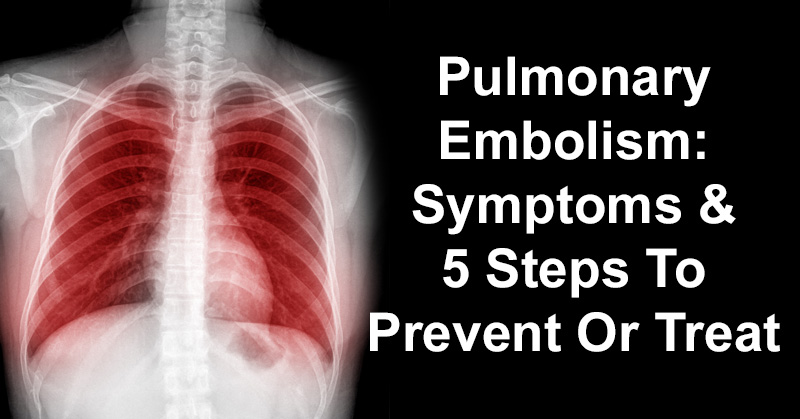Pulmonary embolism is a blockage in one of the pulmonary arteries in your lungs. In many cases, it’s caused by blood clots that travel to the lungs from the legs, or more rarely, from other parts of the body. Pulmonary embolism symptoms include shortness of breath, chest pain, and excessive fever, to name a few. Regarding pulmonary embolism treatment, surgery to remove the clot may be necessary. However, as the clots block blood flow to the lungs, it can be a life-threatening condition. As such, pulmonary embolism prevention methods are key. (1)
Common pulmonary embolism symptoms include: (2)
- Shortness of breath. This usually appears suddenly and worsens with exertion.
- Chest pain. This may feel like a heart attack, and the pain might become worse when you breathe in deeply, couch, eat, bend or stoop. The pain will worsen with exertion but won’t disappear when you rest.
- Cough. It may produce sputum that is bloody.
Other pulmonary embolism symptoms can include:
- Leg pain or swelling, or both, usually in the calf
- Clammy or discolored skin
- Fever
- Excessive sweating
- Rapid or irregular heartbeat
- Lightheadedness or dizziness
Pulmonary embolism prevention is paramount in avoiding a possible life-threatening situation.
Employ these preventative measures as part of a pulmonary embolism treatment plan:
1. Improve Your Diet

Consuming a healthy diet is an important part of pulmonary embolism prevention. While vitamin K may interfere with medication for blood-thinning, foods that contain the vitamin can be part of a healthy diet. Speak to your doctor first if you have a medical condition that might worsen with too much vitamin K. (3)
But as part of a healthy diet, try vitamin K-dense foods such as leafy vegetables, non-starchy veggies like cruciferous veggies, avocado, sweet potatoes, olive oil, berries and bananas.
Additionally, consume plenty of anticoagulant foods and anti-inflammatory foods: (4)
- Foods with vitamin E and vitamin D: For example, fruits, veggies, cage-free eggs and certain kinds of mushrooms
- Spices and herbs, such as garlic, turmeric, oregano, cayenne and ginger
- Real dark cocoa/chocolate
- Fruits like papaya, berries and pineapple
- Raw honey
- Apple cider vinegar
- Green tea
- Evening primrose oil
- Lean healthy sources of protein such as beans, legumes, nuts, seeds
- Stay hydrated. Drink plenty of plain water and other hydrating liquids, such as herbal teas. Avoid added sugar and stay away from too much alcohol or caffeine.
2. Stay Active

You are at a higher risk of PE if you are inactive or have long periods of inactivity. Help keep your blood pressure at a healthy level by such activities as running or cycling, and pair it with some strength training. If you are at risk for pulmonary embolism, try to get up and move around every 15 minutes or so.
3. Maintain A Healthy Weight

Part of a preventative pulmonary embolism treatment is keeping your weight in check. Being overweight puts more pressure on your heart, as well as your other vital organs and blood vessels. Be sure to keep up an active lifestyle as you age, as well. Furthermore, find ways to lower stress and limit your alcohol intake. (5)
4. Check Your Medications
Certain medications are linked to higher incidences of pulmonary embolism. These medications include birth control pills, hormone replacement drugs, and blood pressure medications. Furthermore, drugs used in cancer treatments or for managing autoimmune disorders could interfere with blood clotting. (6)
Speak with your doctor if you take any of these medications, especially if you are at an increased risk for PE due to other conditions.
5. Take Precaution For Increased Risks
There are certain risk factors when it comes to incidents of pulmonary embolism. For example, if any of the following applies to you, you’ll want to take extra care to prevent a PE from occurring:
- being over the age of 40
- suffering from a lower extremity fracture
- suffering from a head injury
- being on a ventilator for more than 3 days
- recovering from venous injury
- having a major operative procedure (7)
Be sure to speak with your doctor if you have a history of any of these risk factors. With the right measures, a pulmonary embolism can be prevented from occurring.


